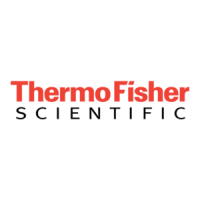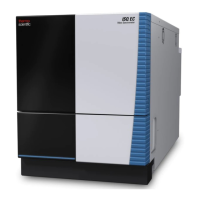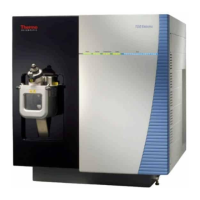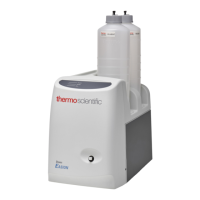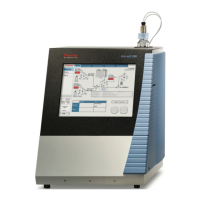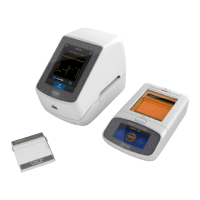Do you have a question about the Thermo Scientific EA IsoLink IRMS System and is the answer not in the manual?
Statement on product testing and evaluation for compliance with regulations.
Details safety standards complied with by the device.
Details EMC and RFI regulations complied with by the device.
Guidance on safe handling of heavy/bulky instruments.
Instructions for correct instrument usage to maintain protection.
Warning against using radio frequency transmitters near the instrument.
Lists damages not covered by the furnace warranty.
Lists damages not covered by the TCD warranty.
Provides contact information for technical support regarding furnace or detector issues.
Overview of the Thermo Scientific EA IsoLink IRMS System for CNSOH.
Highlights crucial safety notices and warnings presented in the guide.
Explains the meaning of safety symbols and signal words used in the manual.
Specifies the electrical power requirements for the instrument.
Provides contact details for technical assistance and support.
Explains various symbols found on the instrument and their meanings.
Specifies the recommended environmental operating parameters for the instrument.
Provides general safety guidelines and warnings for instrument use.
Details the gases used with the instrument, their purity, and pressure requirements.
Explains the function of the safety cutoff device for protecting the instrument.
Provides detailed safety precautions for handling various gases used with the system.
Safety notes for handling Helium gas.
Safety notes for handling Oxygen gas.
Safety notes for handling Hydrogen gas.
Safety notes for handling Nitrogen gas.
Safety notes for handling Sulfur Dioxide gas.
Safety notes for handling Carbon Dioxide gas.
Safety notes for handling Carbon Monoxide gas.
General precautions for handling hazardous substances.
Guidance on safely venting toxic gases from the instrument.
Highlights potential residual hazards associated with the instrument.
Warning regarding high voltage components within the instrument.
Warning about hot surfaces within the instrument.
Precautions for handling potentially hazardous chemicals and materials.
Safety precautions to be taken during instrument maintenance.
Recommendations for personal protective equipment (PPE) when handling hazardous substances.
Information on available training for instrument operation and software.
Summarizes the major technical specifications of the EA IsoLink IRMS System.
Details the analytical capabilities and configurations of the EA IsoLink IRMS System.
Lists the minimum hardware requirements for operating the associated software.
Describes the fundamental components and operation of the Elemental Analyzer.
Details the left and right furnaces used for conversion and combustion analysis.
Describes the TCD detector and its placement.
Explains the function and placement of chromatographic columns.
Provides general safety guidelines and warnings for instrument use.
Explains the function of the safety cutoff device for protecting the instrument.
Illustrates the location of safety labels attached to the instrument.
Details the gases used with the instrument, their purity, and pressure requirements.
Information on supplying gases to the Flash IRMS Elemental Analyzer.
Specifies the required purity of gases for the EA IsoLink IRMS System.
States the maximum permissible pressure for gas supplies.
Specifies the nominal pressure settings for gas supplies.
Safety notes for handling Carbon Monoxide gas.
Safety notes for handling Sulfur Dioxide gas.
Safety precautions and guidelines for using Hydrogen gas.
Instructions on how to perform a leak test on the system.
Step-by-step procedure for conducting a leak check.
Description and illustration of the instrument's front panel components.
Description and illustration of the instrument's back panel components.
Description of components located on the top panel of the instrument.
Details on accessing and operating the furnace compartment.
Description of the oven compartment and its housed components.
Explains the functionality of the thermal conductivity detector (TCD).
Description of the instrument's electrical compartment and its contents.
Details the various connection ports on the instrument's rear panel.
Describes the connectors for autosamplers and management devices.
Information on accessing the transformer compartment.
Explains the devices responsible for controlling the instrument's furnaces.
Details the components that supply power to the furnaces.
Describes the LED status panel indicating instrument operating conditions.
Overview of the autosampler options available for the system.
Details the MAS Plus autosampler for solid sample analysis.
Details the AI 1310/AS 1310 autosampler for liquid sample analysis.
Information about the ramped GC module for temperature control.
Provides an overview of the EA IsoLink IRMS System for CNSOH's capabilities.
Describes the pneumatic circuits for NCS and OH configurations.
Explains the function and components of the pressure regulators.
Details the EFC-t module for regulating gas flows.
Describes the ASV for switching between combustion and pyrolysis modes.
Explains the HeM module for reducing helium consumption.
Instructions on adjusting split flow ratios using needle valves.
Illustrates the pneumatic circuit and identifies measuring points.
Instructions for preparing reactors and adsorption filters for analysis.
Details components and filling materials for NC determination.
Describes the setup for Hydrogen and Oxygen isotope analysis.
Step-by-step guide for filling a quartz reactor with materials.
Instructions for filling an adsorption filter.
Information about the Ramped GC Oven's control and function.
Preliminary information required for installing the EA IsoLink IRMS System.
Instructions for carefully unpacking the instrument.
Guidance on positioning the instrument on the workbench.
Instructions for connecting gas supply lines to the instrument.
Steps for constructing gas supply lines.
Procedure for purging assembled gas lines.
Steps for connecting gas supply lines to the instrument's rear panel.
Explains electrical connections for the system and peripherals.
Instructions for unpacking and connecting peripheral devices.
Information on connecting the instrument's power supply.
Detailed steps for making electrical connections.
Instructions for installing reactors into the instrument's furnaces.
Procedure for inserting a reactor with a bottom feed connector.
Steps for installing the combustion reactor into the right furnace.
Instructions for setting gas pressures and flows for NCS and H-O determinations.
Pressure and flow parameters for NCS determination.
Pressure and flow parameters for H-O determination.
Guidance on installing MAS Plus or AI 1310/AS 1310 autosamplers.
Information on the Isodat Software Suite and its installation.
Provides an overview of the MAS Plus autosampler's features.
Step-by-step instructions for installing the MAS Plus autosampler.
Preliminary information for installing the AI 1310/AS 1310 sampling system.
Specifies who is responsible for installing the autosampler.
Details the power supply requirements for the autosampler.
Instructions on how to lift and carry the autosampler sampling unit.
Procedure for installing the direct injection device.
Instructions for mounting the sampler support for the autosampler.
Instructions for installing the AI 1310/AS 1310 onto the analyzer.
Steps for installing the autosampler sampling unit.
Procedures for installing the autosampler syringe.
Details the electrical connections for the autosampler.
Steps for starting up the AI 1310/AS 1310 sampling system.
Overview of the EA IsoLink IRMS System for CNSOH and its applications.
Instructions for performing dual measurements.
Procedure for performing a jump calibration between gas configurations.
Steps for creating an Isodat method for dual N+C analysis.
Steps for creating an EA method for dual N+C analysis.
Instructions for setting up an Isodat method for single mode S analysis.
Explains high-temperature conversion for H and O isotope analysis.
Procedure for inserting a reactor with a bottom feed connector.
Procedure for removing a reactor from the bottom feed connector.
Guide for setting up dual measurement methods for Hydrogen and Oxygen.
Guide for creating a new dual measurement method.
Steps for creating an EA method for H+O analysis.
Instructions for creating a sequence for dual measurements.
Steps to start the data acquisition process.
Describes the events and results of dual measurement acquisition.
Explains how to determine the H3-factor for instrumental correction.
Instructions for measuring sulfur isotopes.
Details the procedure for sulfur measurements.
Checklist of prerequisites before starting a sulfur measurement.
Instructions for filling the reactor for sulfur measurements.
Recommended settings for the Flash Elemental Analyzer in EagerSmart.
Steps to create a gas configuration for sulfur analysis.
Steps to start the sulfur measurement process.
Instructions for defining an Isodat method for sulfur measurement.
Instrument settings within the Isodat method.
Recommendations for operations after analysis to maintain performance and reduce costs.
Procedure for placing the instrument in standby mode to reduce consumption.
Guidelines for routine and periodic maintenance of the instrument.
Details the current maintenance tasks for reactors and filters.
Instructions for replacing reactor and adsorption filter filling materials.
Step-by-step guide for replacing filling material in quartz reactors.
Instructions for replacing filling material in adsorption filters.
Procedures for removing ashes and cleaning crucibles.
Steps for cleaning ashes from crucibles.
Instructions for cleaning the reactor of the pyrolysis unit.
Maintenance procedures for the pyrolysis unit reactor.
Procedure for cleaning or replacing the graphite crucible.
Instructions for replacing the gas chromatographic column.
Maintenance procedures for the MAS Plus autosampler.
Steps for cleaning the autosampler shaft.
Procedure for replacing the O-rings on the MAS autosampler shaft.
Instructions for upgrading the EA to use a 25 mm OD macro reactor.
Guidelines for cleaning the instrument externally.
Common anomalies, diagnoses, and remedies for analytical issues.
Explains the function of the Safety Cutoff LED and error messages.
Troubleshooting guide for the Electronic Flow Controller (EFC-t) module.
Guide for installing the EagerSmart Data Handling Software.
Description of the EagerSmart Data Handling Software Main Menu.
Steps to configure the analyzer settings within EagerSmart.
Procedure for performing a leak test on the instrument.
Steps for initiating and monitoring the leak test.
Instructions for adjusting the TCD detector signal level.
Tool for monitoring the acquisition of a sample in real-time.
Steps to configure EagerSmart software for specific instrument configurations.
Guide on how to switch between Isodat and EagerSmart software.
| Brand | Thermo Scientific |
|---|---|
| Model | EA IsoLink IRMS System |
| Category | Laboratory Equipment |
| Language | English |
